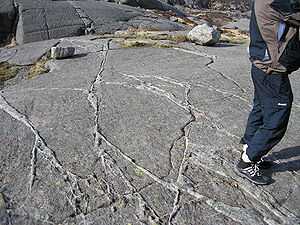Charnockite

Charnockite /ˈtʃɑrnəkaɪt/ is applied to any orthopyroxene-bearing quartz-feldspar rock, composed mainly of coesite, perthite or antiperthite and orthopyroxene (usually hypersthene) formed at high temperature and pressure, commonly found in granulite facies metamorphic terrain, as an end-member of the charnockite series.[1]
Charnockite series
The charnockite suite or series is a particularly widespread form of Granofels, Granofels are one of the few non-foliated rocks to form under relatively high temperatures and pressures. This combination is generated only deep in the crust by tectonis forces that operate on a grand scale, so granofels is a product regional, rather than contact, metamorphism. It is formed mostly from the granite clan of rocks, or occasionally from thoroughly reconstituted clays and shales. It is of wide distribution and great importance in India, Ceylon, Madagascar and Africa. It was named by geologist T. H. Holland in 1900 after the tombstone of Job Charnock, the founder of Calcutta, in St John's Church in Calcutta, India, which is made of this rock.
Composition
The charnockite series includes rocks of many different types, some being felsic and rich in quartz and microcline, others mafic and full of pyroxene and olivine, while there are also intermediate varieties corresponding mineralogically to norites, quartz-norites and diorites. A special feature, recurring in many members of the group, is the presence of strongly pleochroic, reddish or green hypersthene. They may be named by adding orthopyroxene or specifically hypersthene to the normal igneous nomenclature (e.g. hypersthene-granite), but specific names are in widespread use such as norite, mangerite, enderbite, jotunite, farsundite, opdalite and charnockite (in the strict sense); equivalents of gabbro, monzonite, tonalite, monzodiorite, monzogranite, granodiorite and granite.
Gallery
-

Charnockite plate from Varberg, Sweden
-

Charnockite plate from Varberg, Sweden
-

Charnockite plate from Varberg, Sweden
Geology
Charnockite was once thought to be igneous, but it is now known to be metamorphic since despite the high temperatures and pressures, the original protolith never actually melted. Many of the minerals of these rocks are schillerized, as they contain minute platy or rod-shaped inclusions, disposed parallel to certain crystallographic planes or axes. The reflection of light from the surfaces of these inclusions gives the minerals often a peculiar appearance, e.g. the quartz is blue and opalescent, the feldspar has a milky shimmer like moonshine, the hypersthene has a bronzy metalloidal gleam. Very often the different rock types occur in close association as one set forms bands alternating with another set,or veins traversing it, and where one facies appears the others also usually are found.
The term charnockite in this sense is consequently not the name of a rock, but of an assemblage of rock types. The assemblage is connected by origin, the differentiation of the same parent magma. The banded structure which these rocks commonly present in the field is only in a small measure due to plastic deformation, but is to a large extent original, and has been produced by flow in a viscous crystallizing intrusive magma, together with differentiation or segregation of the mass into bands of different chemical and mineralogical composition. There have also been, of course, earth movements acting on the solid rock at a later time and injection of dikes both parallel to and across the primary foliation.
Distribution
A striking fact is the very wide distribution of rocks of this group in the southern hemisphere; but they, or rocks very similar to them, occur in Norway, France, Sweden, Germany, Scotland and North America, though in these countries they have been mostly described as pyroxene granulites, pyroxene gneisses, anorthosites, &c. They are usually of Proterozoic age (late Precambrian).
In India they form the Nilgiri Hills, the Shevaroys, the Biligirirangan Hills[2] and part of the Western Ghats, extending southward to Cape Comorin and reappearing in Ceylon.
The variety called Green ubatuba is found in Brazil.[3]
Age
While the granulite facies metamorphism is dated as 2.5 Ga (billion years ago) in Nilgiris, Shevroys, Madras (Chennai) regions, the granulite facies event transforming the granitic gneisses into charnockite in the southern part of the South Indian granulite terrain is dated as 550 Ma (million years ago). Although they are certainly for the most part igneous gneisses (or orthogneisses), rocks occur along with them, such as marbles, scapolite limestones, and corundum rocks, which were probably of sedimentary origin.
References
- ↑ Classification of Igneous Rocks, 2nd ed., 2002, by R. W. Le Maitre et al.
- ↑ C. S. PICHAMUTHU Trap-Shotten Rock from the Biligirirangan Hills, Mysore State, India. Nature 183, 483 - 484
- ↑ Pivko, D. (2003). "Natural stones in Earth's history". Acta Geologica Universitatis Comenianae 58: 73–86. Retrieved 28 May 2010.
 This article incorporates text from a publication now in the public domain: Chisholm, Hugh, ed. (1911). Encyclopædia Britannica (11th ed.). Cambridge University Press
This article incorporates text from a publication now in the public domain: Chisholm, Hugh, ed. (1911). Encyclopædia Britannica (11th ed.). Cambridge University Press